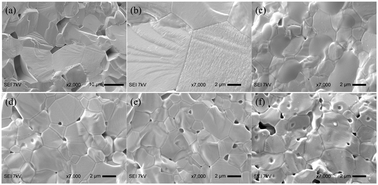Colossal dielectric permittivity in Co-doped ZnO ceramics prepared by a pressure-less sintering method
Abstract
Dielectric properties and impedance spectroscopic studies of single phase Zn1− xCoxO (0 ≤ x ≤ 0.05) ceramics, synthesized by a pressure-less solid state reaction method, have been carried out to investigate the origin of colossal dielectric permittivity (CP), ε′ ∼ 105, in a wide frequency (2 × 101–2 × 106 Hz) range. These results show that a defect density within the grain is present in the materials due to the use of pressure-less sintering at high temperature for a long duration of time. The colossal dielectric response is essentially due to this electronic inhomogeneous conduction mechanism within the material due to the production of absorption current in the thin grain boundary region which accumulates charge at the interface and induces Maxwell–Wagner interfacial polarization. Moreover, this defect structure further increases with the addition of Co ions and enhances the CP property. An effective way to control the colossal dielectric properties is to control the defect density within a grain by using a proper sintering method.



 Please wait while we load your content...
Please wait while we load your content...